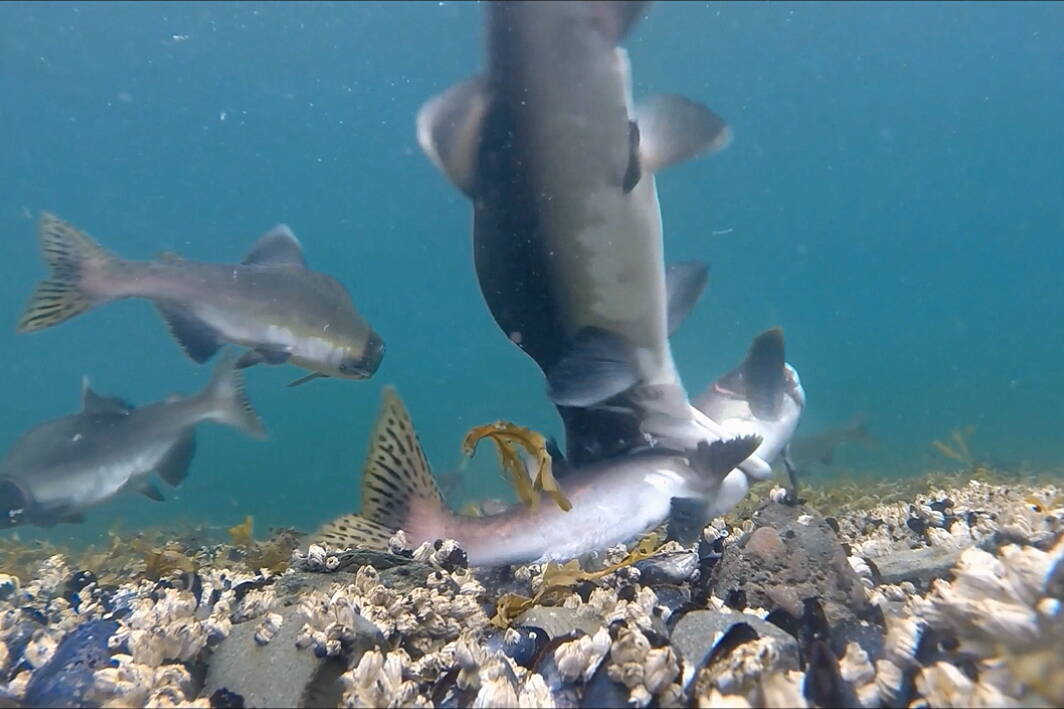A walk at Eagle Beach Rec Area often yields something to think about. Here are two examples, unrelated to each other except for the location.
A very high tide in early September left surprisingly little trash on the beach for me to pick up. What it did leave were dozens of salmon carcasses and remains. There were chum salmon carcasses in various stages of decomposition, ranging from shreds of skin to full-bodied corpses. The canny avian scavengers knew to grab the eyes and to probe into the abdomen for eggs, but some carcasses were untouched. Among all those chum were a few pink salmon, almost undamaged. Clearly, the scavengers were sufficiently well-fed to be highly selective in their choices.
The chum run was over, but coho were working their way up the river in a long line close to the shore. In the murky water only the dorsal fins and a shadowy body showed their gradual progress. They still had a long way to go to their spawning grounds upstream.
Pink salmon have spawning runs from late summer into October. Some runs go far upstream: here, I’ve seen them way up Montana Creek past the junction with McGinnis Creek. Sometimes, however, pinks spawn in estuaries and the sub- and inter-tidal zone, particularly if there are up-wellings. Pinks typically mature when they are two years old. That means those hatched in even-numbered years cannot usually breed with those hatching in odd-numbered years, and effectively they form two separate populations whose patterns of abundance are not closely tied to each other. Those two populations seldom interbreed and may undergo separate evolutionary changes.
Although mature salmon are known to return to their natal streams for spawning, sometimes they stray to other streams; some reports indicate that straying is more common in years of high spawning numbers. As more and more streams are degraded and the ocean warms, we may find that increasing numbers of salmon explore the Arctic coasts; mature adults of all salmon species have already been found along that coast in western Canada.
The strawberries that grow here seem to have a long flowering season: I can find a few rather lonely flowers even in early September. At Eagle Beach there’s an extensive patch of them growing on a raised sand terrace. I seldom see ripe fruit on these plants, perhaps because the area is so trampled or because avid harvesters get there quickly.
Our native strawberry is named Fragaria chiloensis. I’ve wondered for a long time about that formal name. The genus name comes from a Latin word for strawberry. But the species name reminded me of the Chilean island of Chiloḗ, where I once had a little field station and spent several years studying rainforest birds. And that seemed weird. I finally got around to looking up some information about our strawberries and that helps explain the species name.
The geographic range of this species extends along the coast from the Aleutians to California, although it has hopped over the mountains in a couple of places. It is native to two islands in Hawaii, no doubt carried there by shorebirds that sometimes eat fruit. By the same means, it also made another long jump to southern South America, where it actually does grow on Chiloḗ. There some Chilean friends recently harvested some fruits, finding the plants growing on sandy soils as they do here. It also occurs on the coasts of the central Chilean mainland.
It has been established in Chile for hundreds of years and was cultivated extensively by native cultures. Somewhat more recently, the Spanish invaders carried it along the coast to Peru and Ecuador. So it has a long history of domestication.
There are numerous species of strawberry, and many of them are inter-fertile, making hybridization common (and making it difficult to define a species). Most or all of the species are polyploids (having more than one set of chromosomes). Some have six or eight sets of chromosomes, presumably arising as a result of multiple hybridizations. Our species probably came from a similar polyploid that lives in the Kuril Islands between Japan and Kamchatka, jumping from there to the Aleutians and then moving down the coast. That was probably also the original source of a species (F. virginiana) that lives in eastern North America.
The original commercial strawberry is said to have started as an accidental hybrid of F. chiloensis and F. virginiana in European gardens. When Europeans settled North America and brought those plants with them, the hybrid was then crossed with more of the original sources. That complex is the basis for the numerous cultivars of strawberry.
Most strawberry flowers are hermaphrodite, bearing both male and female sex organs. But there can be separate male and female flowers and even some neuters (which have no sexual functions). It seems that the proportions of these gender variants differ in different cultivars and populations. In addition to sexual reproduction, strawberry plants can reproduce asexually, by producing runners that develop new little plants along their length. This enables the colonization of nearby vacant spots, but natural dispersal (not assisted by humans) to new areas depends on birds and mammals that eat the fruit and drop the seeds.
• Mary F. Willson is a retired professor of ecology. “On The Trails” appears every Wednesday in the Juneau Empire.

